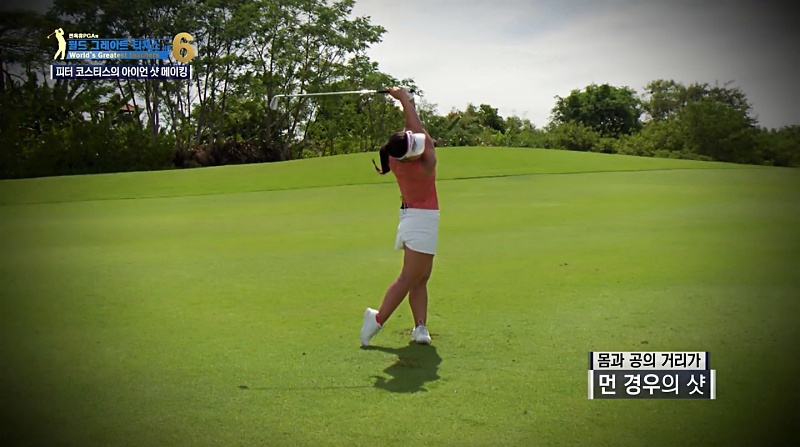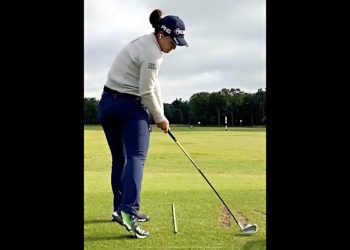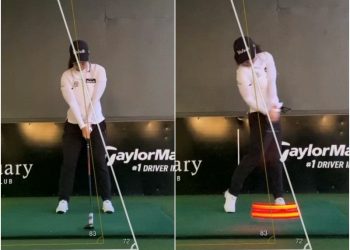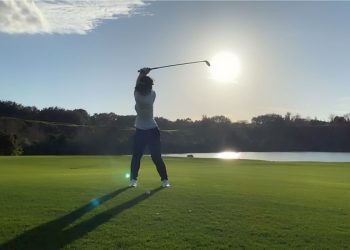골퍼라면 누구나 쉽게 볼의 탄도를 조절하고 싶어 한다. 볼의 탄도를 조절하면 바람을 잘 활용할 수 있다. 바람이 얼굴 쪽에서 불어오면 볼을 낮게 친다. 하지만 뒤쪽에서 바람이 분다면 높게 쳐야 한다. 그래서 골프 용어로 바람의 방향을 이야기할 때는 헤드 윈드(Head Wind)와 테일 윈드(Tail Wind)라고 한다.

이번엔 클럽을 바꾸지 않고 볼의 탄도를 조절하는 요령을 소개한다. 골프에서는 클럽을 가지고 자유롭게 볼을 원하는 방향, 탄도 그리고 휘어지게 치는 등의 요령을 모두 샷 메이킹이라고 한다.
바람 속에서는 대부분 스윙이 빨라진다. 몸의 움직임이 느려지고 긴장도 생기기 때문이다. 환경이 변화된 상태일수록 더 기본으로 돌아가 집중해서 샷을 하는 것이 중요하다. 항상 정상적인 스윙의 리듬을 지킬 수 있어야 스윙의 타이밍을 가져갈 수 있다.
자주 만나는 상황은 아니지만, 가끔은 의도치 않게 볼의 탄도를 낮게 쳐야 할 때가 있다. 맞바람 상황에서다. 볼의 탄도를 조절하는 방법은 수많은 방법이 있다. 하지만 코스에서 환경이 갑자기 돌변하면 신속하게 상황을 파악해 간단하게 대처할 수 있어야 한다.
그중 하나가 어드레스 때 볼과 몸의 간격을 넓히거나 좁혀서 탄도를 조절하는 것이다. 먼저, 일반적인 볼과 몸의 간격을 이해할 필요가 있다.
클럽별로 크게 3가지로 나눌 수 있다. 숏 아이언 샷은 정상적인 어드레스 자세에서 왼팔을 어깨로부터 수직으로 내려놓은 상태에서 클럽을 잡으면 된다.
중간 길이에 해당되는 5번 아이언의 경우 왼팔이 수직 상태보다는 약 2~3cm 볼 쪽으로 옮겨진 상태로 그립을 잡는다.
그리고 같은 요령으로 드라이버샷은 5~6cm 정도 수직에서 이동된 상태로 그립을 잡게 된다.
3개의 볼을 앞에 정렬해 놓고 자세를 취한다. 선택한 클럽을 가지고 정상적인 자세를 취하며 볼을 놓고, 2개의 볼을 몸에 더 가깝게 안쪽에, 그리고 다른 하나는 정상 위치보다 더 멀리 놓는다. 가장 멀리 놓인 볼의 탄도가 가장 높게 날아간다. 가장 몸 가까이 놓인 볼은 상대적으로 낮은 탄도로 날아간다. 놓인 3개의 볼 간격은 볼 하나가 들어갈 공간보다 조금 여유 있게 하면 된다.
탄도를 낮게 쳐야 할 경우, 몸 가까이 놓인 볼을 어드레스 때 그립을 내려 잡는다. 그런 후 정상적인 풀스윙을 하면 볼의 탄도는 정상적인 상태보다 낮게 날아간다. 정상 위치보다 가장 멀리 놓인 볼은 가장 높게 날아간다. 스윙의 궤도도 상대적으로 얕아진다. 몸 뒤쪽에서 바람이 불 때 클럽을 바꾸지 않고 좀 더 몸에서 멀리 서서 치면 된다.
샷 메이킹을 할 때는 어떠한 상황에서든지 기본을 정확하게 이해한다면 유연하게 대처할 수 있다.
☞ 전욱휴는…
골프 칼럼니스트. PGA 클래스A 멤버이자 공인 티칭 및 코칭 강사다. SBS, MBC, JTBC, YTN 등의 골프 채널에서 진행자 및 해설자로 활약했다. 현재 애틀랜타에서 골프 레슨 및 골프 관련 비즈니스를 하고 있다. chungolf@gmail.com
[Dr.Eric Chun’s Golf Lesson] 20. Tips for Controlling Ball Trajectory
Hit the ball high when there’s a tailwind!
Every golfer wants to easily control the ball’s trajectory. When you manage the ball’s trajectory, you can effectively use the wind to your advantage. If the wind is blowing towards your face, hit the ball low. However, if the wind is blowing from behind you, hit it high. In golf terminology, we call these wind directions headwind and tailwind.
In this lesson, I will introduce tips on adjusting the ball’s trajectory without changing clubs. In golf, the skills to freely direct the ball, adjust its trajectory, and shape shots are collectively known as shot making.
Swings often become faster in windy conditions. This happens because body movements slow down, and tension builds up. Returning to the basics and focusing on making the shot becomes more crucial in changing environments. Maintaining a normal swing rhythm is essential to keep your swinging timing intact.
Although it’s not always common, there are times when you need to hit the ball with a lower trajectory, like in a headwind situation. There are many ways to adjust the ball’s trajectory. However, when conditions on the course suddenly change, you need to react swiftly and simply. You should be able to handle it quite easily.
A method to adjust trajectory is by widening or narrowing the gap between the ball and your body during address. First, it’s necessary to understand the general gap between the ball and your body. This can be broadly divided into three categories based on the club. For a short iron shot, in a normal address position, you should grip the club with your left arm hanging vertically from your shoulder. For a 5-iron, which is of medium length, position your left arm about 2-3 cm closer to the ball than vertical while gripping. Likewise, for a driver shot, grip the club with your left arm about 5-6 cm closer to the ball than vertical.
Align three balls in front of you and take your stance. With your selected club, take your normal stance, placing one ball in the normal position, two others closer to your body, and one further away. The ball placed furthest from you will fly the highest. The ball closest to you will fly with a relatively low trajectory. The gap between the three balls should be slightly more than the space needed for one ball.
When you need to hit the ball lower, grip down on the ball set closest to your body during address. Then, execute a normal full swing, and the ball’s trajectory will be lower than usual.
The ball placed furthest from your normal setup will fly the highest. The swing arc will also be relatively shallower. When the wind is blowing from behind, simply stand further away from your normal position to hit without changing clubs.
When engaging in shot making in various situations, always start from the basics. A precise understanding of the basics allows you to adapt flexibly to different conditions.




![[전욱휴의 골프레슨] 20. 볼의 탄도 조절](https://www.atlantajoongang.com/wp-content/uploads/2024/08/Q2KakaoTalk_20240808_071423020_01-750x426.jpg)















![[전욱휴의 골프레슨] 34. 드라이버 똑바로 멀리치기](https://www.atlantajoongang.com/wp-content/uploads/2024/11/collage-350x250.jpg)

![[전욱휴 골프레슨] 32. 드라이버 샷 메이킹](https://www.atlantajoongang.com/wp-content/uploads/2024/10/aKakaoTalk_20241031_071444145_01-350x250.jpg)









